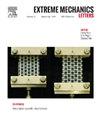具有可调柔性行为的三维形变超材料
IF 4.5
3区 工程技术
Q2 MATERIALS SCIENCE, MULTIDISCIPLINARY
引用次数: 0
摘要
柔性增氧超材料在工程应用中显示出巨大的潜力。然而,大多数现有的柔性增减超材料仅限于二维(2D)设计,限制了它们在实际三维工程场景中的应用。在这里,我们代表了一种通用的设计策略,通过在旋转刚性框架中嵌入弹性弹簧的桁架晶格,展示了非凡的灵活性,可恢复性和可编程性。我们通过实验、数值和理论分析,以偏心弹簧连接旋转八联体桁架结构(ROCT-S)为例说明了这种方法。在面内张拉作用下,在平均应变为161 %时,所提出的偏心弹簧连接两方向旋转八柱桁架结构(ROCT-S-2D)的工程应力约为基材模量的9.4 × 10−6。同时,ROCT-S-2D在面外压缩下的可编程力学性能与面内性能正在解耦,可以承受超过自身重量12,800倍的载荷。ROCT-S的坚固和适应性强的机械性能突出了其广泛的适用性,从电子和生物医学设备到可穿戴的柔性防护装备,为先进的3D auxetic超材料在实际工程解决方案中的应用铺平了道路。本文章由计算机程序翻译,如有差异,请以英文原文为准。
Three-dimensional auxetic metamaterials with extremely tunable flexible behavior
Flexible auxetic metamaterials has demonstrated significant potential in engineering applications. However, most existing flexible auxetic metamaterials are limited to two-dimensional (2D) designs, restricting their utility in real 3D engineering scenarios. Here we represent a versatile strategy for designing 3D auxetic metamaterials that showcase extraordinary flexibility, recoverability, and programmability which is accomplished by embedding truss lattice with elastic spring into rotating rigid frameworks. We exemplify this approach with the eccentric spring connected rotating octet truss structures (ROCT-S) through experimental, numerical, and theoretical analysis. Under in-plane tension, engineering stress of the proposed eccentric spring connected rotating octet truss structures in two directions (ROCT-S-2D) is approximately 9.4 × 10−6 of the base material’s modulus at an average strain of 161 %. Simultaneously, the programmable mechanical performance of the ROCT-S-2D under out-plane compression is decoupling with their in-plane performance and can be designed to support a load exceeding 12,800 times its own weight. The robust and adaptable mechanical performance of ROCT-S highlight its broad applicability, spanning electronics and biomedical devices to wearable flexible protective gear, paving the way for advanced 3D auxetic metamaterials in practical engineering solutions.
求助全文
通过发布文献求助,成功后即可免费获取论文全文。
去求助
来源期刊

Extreme Mechanics Letters
Engineering-Mechanics of Materials
CiteScore
9.20
自引率
4.30%
发文量
179
审稿时长
45 days
期刊介绍:
Extreme Mechanics Letters (EML) enables rapid communication of research that highlights the role of mechanics in multi-disciplinary areas across materials science, physics, chemistry, biology, medicine and engineering. Emphasis is on the impact, depth and originality of new concepts, methods and observations at the forefront of applied sciences.
 求助内容:
求助内容: 应助结果提醒方式:
应助结果提醒方式:


